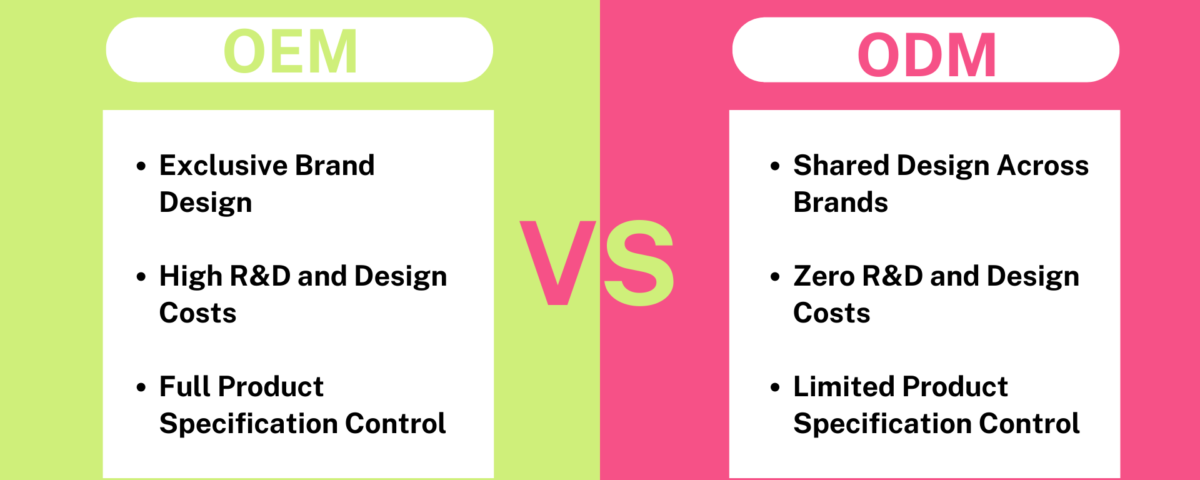
Turn Your Product Idea into Reality with Manufacturers from China
June 19, 2025
How to Import Christmas Decorations in Bulk from China: A Complete Guide for U.S. Retailers & Wholesalers
June 25, 2025Key Highlights
- Gain clarity on the differences between OEM (Original Equipment Manufacturer) and ODM (Original Design Manufacturer) models, crucial for product sourcing in China.
- Explore how each approach affects product development, branding opportunities, and profit margins.
- Understand the relevance of intellectual property protection within the Chinese manufacturing landscape.
- Learn about core quality control practices and strategies for selecting the ideal manufacturing partner.
- Review practical steps to navigate the supplier network for Chinese manufacturers and safeguard your business needs effectively.
- Assess the pros and cons of OEM vs ODM to make informed decisions that align with your business goals.
Introduction
In the world of manufacturing, you will see two main models: OEM and ODM. These models play a big part in product design and the supply chain. Picking either one will change how your brand looks, what your production costs are, and how you do in the market. If you want to put out products that stand out or need better ways to make your goods, knowing about oem vs odm is important. This guide will help you see what makes these two models different, so you can make smart choices when you work with Chinese manufacturers.
Understanding OEM and ODM Manufacturing in China

Working with Chinese manufacturers usually means you have to choose between OEM manufacturing and ODM manufacturing. You need to pick the one that fits your business the best. Each of these has a different way of making products. The method you use can change how much control you have over the design, what your production costs will be, and how fast you can get your product out to people. You should understand how both work so you can know what fits your business.
With OEM manufacturing, you are in control of the design. You and your team have to be very involved through every step, from the idea to how the product is made. On the other hand, ODM manufacturing is easier. The manufacturer has a product ready, and you just make small changes to fit what you want. Now, let’s go into more detail and see the differences between these ways of working.
Definitions of OEM and ODM
An Original Equipment Manufacturer (OEM) is a company that makes products, but these products follow the detailed ideas and needs of the client. The client keeps full control over the product design and gives the OEM their own special plans. The OEM then handles the manufacturing process and uses the client’s brand name. This setup is good for businesses that want to have complete control over how the product looks and what name is on it.
On the flip side, an Original Design Manufacturer (ODM) creates products from its own original design. Clients can choose these ready-made items and use white-label or private-label ways to put their own brand name or special packaging on them. This is quicker and means you spend less time and money, so it is best for those who want to launch products fast and need less input on design.
Where original equipment manufacturers let you shape your own ideas, original design manufacturers let you get products faster with little to no work on designing. The choice depends on your business goals. Do you want more customisation and control, or do you prefer speed and lower costs? Both ways can help business goals in different and effective ways.
How OEM and ODM Differ in Practice
When you compare OEM vs ODM, you need to know how their manufacturing models work. With OEM manufacturing, the process starts fresh. The client is in control, shaping product development from the very start. This lets you change every part to make a unique product just for you. On the other hand, ODM manufacturing uses designs that are already made, but you can adjust them. This lets businesses get their products to market faster.
The level of involvement is different in each model. If you use OEM, you have to take part in every step. This includes planning how things get made, designing, and checking if everything works well. It is a good choice if you want high-quality and made-to-order goods. With ODM, you can only make a few changes. You will likely just put your own branding or update the packaging, not change the main features.
OEM helps you stand out but costs more money and time. Sometimes, building from the ground up means longer lead times. When you use ODM, it is less expensive and much faster. You can get your item to the people quicker. This works well for mass-market or existing products, which is good for businesses that want to spend less. The best choice depends on what you want for your company, and what matters most to your day-to-day work.
OEM Process Steps in China
The OEM process in China has a few main steps that help things run smooth. Here is a simple guide:
- Research and Design: Clients share what products they want. They give the details for their design, including things like the materials and how the product should work.
- Prototyping and Sampling: The manufacturer makes a first version of the product. This lets everyone check how good it is before making many.
- Mass Production: If the first version looks good, the factory starts making more products. There is strong quality control the whole time.
- Packaging and Delivery: When the products are ready, they are packed to match the client’s brand. After that, the goods are shipped out.
Advantages and Disadvantages of OEM
| Advantages | Disadvantages |
|---|---|
| Have complete control over design | Need to pay higher upfront costs |
| Customisation for your business needs | Have to wait longer lead times because of slower development |
| Get economies of scale when you make more | Can have mistakes if you do not have strong partners |
| Stand out more in the market | Might face higher per-unit pricing |
OEM manufacturing lets a company have complete control over what they make. It helps you build branded products that match your business needs and ideas. You will need to spend a lot from the start. The time for making your product can be long, and this can be hard for some. Still, you get better quality and make your brand stand out more, which can be worth it. Think about these things to see if OEM will work for your business.
ODM Process Steps in China
For businesses that want to use odm manufacturing, the basic production process works like this:
- Select Pre-Designed Products: You pick from catalogs that suppliers show you. These lists are different based on your industry and what you need.
- Customisation: You make changes like adding your brand, changing how it looks, or updating little features, so the product fits your business.
- Mass Production: Next, manufacturers make a lot of your chosen product in safe, controlled spaces.
- Delivery and Quality Assurance: After this, the goods get checked for quality, packed up, and sent to you.
Working with a good manufacturing partner makes everything easier. The smooth production process helps get orders done faster. This is because there is no need to start with long, detailed design jobs for every new project.
Advantages and Disadvantages of ODM
| Advantages | Disadvantages |
|---|---|
| Faster time-to-market due to ready designs | Limited customisation options |
| Cost-effective for tight budgets | Less unique design than others |
| Good for low-complexity products | There is a risk of features being the same as competitors |
| Proven product designs lower risks | Depend fully on what the supplier can do |
The odm model helps you get products to the market faster and for less money. But with this way, you have less control and fewer options to make a unique design for your product. It is good for the first steps when people or companies need an affordable choice. Before picking this model, you have to think about if it fits your brand’s bigger goals in the future.
Key Factors to Consider When Choosing OEM or ODM

It is important to pick the right supplier and to know how they work. This will help you rely on them and meet what the market wants. Now, let’s talk about how production costs and economies of scale can affect your planning.
Cost Implications and Budget Planning
Budget is a key part in choosing between OEM manufacturing and ODM models.
- Production Costs: OEM manufacturing often has higher production costs because of the work that goes into new designs. ODM manufacturing saves money as it uses pre-designed templates.
- Minimum Order Quantity: With OEM, you may have to buy more at one time. ODM manufacturing lets you make smaller orders, which gives you more freedom.
- Economies of Scale: Making more goods at once is more cost-effective with the OEM model, especially for things like electronics.
- Profit Margins: ODM’s lower starting costs help startups get better profit margins. OEM can give you good margins too, but this comes with unique or detailed work.
When you look at what fits your goals, you can get the right model for your budget and the way you want to grow.
Customization, Branding, and Intellectual Property
Customization is a big part of OEM. It helps businesses make products that fit their own needs. This is good for building a strong brand identity. On the other hand, ODM lets you make only a few changes to the design, such as adding your own brand name or changing the box.
Keeping your intellectual property safe is important for both models. People worry a lot about things being copied or stolen. With OEM, you have more control over the design and plans, so your intellectual property rights are safer. In ODM, you have to make clear agreements if you want to stop others from using your unique design or ideas.
When you choose between OEM and ODM, think about what matters to you more. Is it having your own brand name and controlling your brand identity? Do you want to protect a unique design? The model you pick can change how people see your brand and where you stand in the market later on.
Navigating Supplier Selection in China
Finding the right supplier in China takes careful checking. A good manufacturer or sourcing agent in this area needs to have many years of experience in the manufacturing process. Websites like Global Sources help you find trustworthy manufacturing partners with less trouble.
Checking if they follow rules and have a strong track record is key to keeping product quality steady. That goes for both OEM and ODM products. Next, we will talk about tips to see how reliable a supplier is and how to make clear contracts to protect yourself.
Assessing Supplier Reliability and Compliance
To check how reliable a supplier is, look at these important areas:
- Track Record: The supplier should show a history of work and share examples of good quality control in past projects.
- Regulatory Compliance: The supplier needs to follow both local and global rules for making products.
- Production Process: Find out how the supplier keeps to agreed times and meets delivery dates.
- Product Quality: Ask the supplier for samples. This helps you see if they can keep the same product quality in every batch.
Working with trusted manufacturing partners helps you avoid expensive issues. A reliable supplier gives you trust in your production process and helps your work go smoothly.
Negotiating Contracts and Quality Control
Making deals with Chinese manufacturers needs careful contract negotiations and strong quality control steps.
When you write contracts, clearly list the details for the production process, timelines, and what happens if there are defects. Put in place ways to check finished goods. This will help make sure the final product is as expected.
Watch the work during production all the time. This helps cut down on risks and makes sure the final product meets market standards. When you and the supplier work together, both sides gain benefits at every step as you go from start to finish.
Conclusion
To sum up, knowing the difference between OEM and ODM manufacturing in China can help your business do well in the market. Both types have their own good points and bad points. These can change how you handle your production process, control costs, and shape your brand identity. You should think about things like how much you want to change your product, your budget, and how much you trust the supplier. This will help you make the best choices that fit your business goals. If you make the right moves, you can work better with others and offer better products. If you want help that fits your needs, get a free talk with our experts today!
If you are looking for a team in China to find you OEM and ODM factories and assist in whole process of development , communication and negotiations with OEM and ODM factories , then get in touch with Nexofetch
Visit :https://nexofetch.com/
Email : support@nexofetch.com
Frequently Asked Questions
What is the main difference between OEM and ODM in China?
OEM manufacturing means making a new product design that is managed by the client. On the other hand, ODM manufacturing gives you products based on a plan that is already made, but you can make some small changes to it. Both OEM manufacturing and ODM manufacturing fit different business models depending on what people need. When thinking about product development or wanting a unique product, you have to know which way to go.
Which model offers better protection for my product design?
For better protection of your intellectual property, OEM manufacturing is the best choice. You keep complete control over your unique design. ODM manufacturing can be easier and faster, but you need to have clear agreements with your manufacturing partner. This helps protect your IP rights.
Is it easier to customise products with OEM or ODM?
The oem process lets a business change a lot of things. You can even design something new that fits what you want. This is good for people who need a special look or feel for their item. But with the odm process, you work with what is already there. It lets a company make some small changes to something made before. This is a good fit if you want things done fast and do not want to get too deep into the work.
What are the risks of working with Chinese manufacturers?
Key risks can be poor quality control, waiting too long in the production process, and trouble in the supply chain. When you pick the right supplier and protect your intellectual property with careful contracts, you help with these problems. This will make it easier for your business to do well and avoid most issues.
How do I find reliable OEM or ODM suppliers in China?
You can explore platforms like Global Sources to find what you need. Another good way is to hire a sourcing agent who has many years of experience. Verified manufacturing partners with a long history of good product quality help the work go smoothly.







